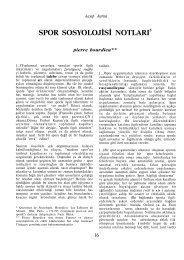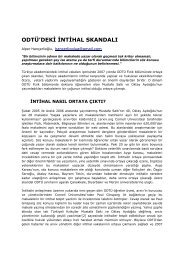Untitled
Untitled
Untitled
Create successful ePaper yourself
Turn your PDF publications into a flip-book with our unique Google optimized e-Paper software.
16 INTRODUCTION<br />
the organization of work in the modern big firm, to which the next<br />
chapter is devoted. Similarly the chapter 'Among neighbours', which<br />
among other things exposes divide et impera methods within the firm, is<br />
a revealing commentary on the neo-paternalist ideologies of community<br />
described in the previous section.<br />
The montage principle is even more obvious within the individual<br />
sections. The chapter 'Alas, so soon!', which deals with the 'laying ofi�<br />
of employees, begins with the description of a man who - 'Opposite the<br />
Kaiser Wilhelm Memorial Church, where the Gloriapala�t and Marmorhaus<br />
salute each other like proud castles on the Dardanelles' - stationed<br />
himself with a plaque indicating that he 'was a 25-year-old unemployed<br />
salesman, who was seeking work on the open market - no matter what<br />
kind' The plaque documents the growing unemployment that affects<br />
even people with skills. But the material does not speak for itself. For<br />
what is decisive is the fact that, as a 25-year-old, the man already counts<br />
as an older worker. The commentary appears in the advertisement<br />
quoted next, from a menswear store that would like to engage 'an older<br />
salesman of twenty-five or twenty-six'<br />
I,ike the montage of the material, the form of its linguistic mediation<br />
- quotation, conversation, report, narrative, scene, image - depends<br />
011 the k llowl edge of its significance. The chapter 'Repair shop' reads<br />
like the outline of a story. Its narrative structure mirrors the actual<br />
("Olllle :tion between works council, Labour Court and labour exchange,<br />
the path of plaintiffs and complaints through the institutions. In the<br />
passages on the Labour Courts, 'close-ups' delay the progress of<br />
the bare narrative, in order to call attention to those apparent trifles<br />
which, in the light of the courtroom, 'emerge with unwonted clarity'<br />
Individuals who have been sacked are introduced: a salesgirl who<br />
advised a friend to buy her shoes more cheaply in another store; a<br />
young employee whose private notebook was confiscated during a bodysearch<br />
by his firm; an elderly sales representative who seeks to furnish<br />
proof of his bourgeois origins through Latin quotations. The dramatic<br />
form of presentation is mimetically adapted to the actual situation of<br />
the hearings, through which 'nasty tricks, common practices, economic<br />
relations and social conditions are not documented but present<br />
th(�mselves in them'<br />
The chapter 'A few choice specimens', inserted between the analysis<br />
of salaried employees' material living conditions and that of the<br />
ideologies superimposed on this reality, is devoted to the 'features,<br />
patterns and phenomena' which do not readily coincide with the<br />
'image' that has been formed in the 'general consciousness' of the<br />
salaried stratum. The 'dashing' cigarette salesman who lives in a kind<br />
of 'preordained harmony' with the demands of modern life; the






